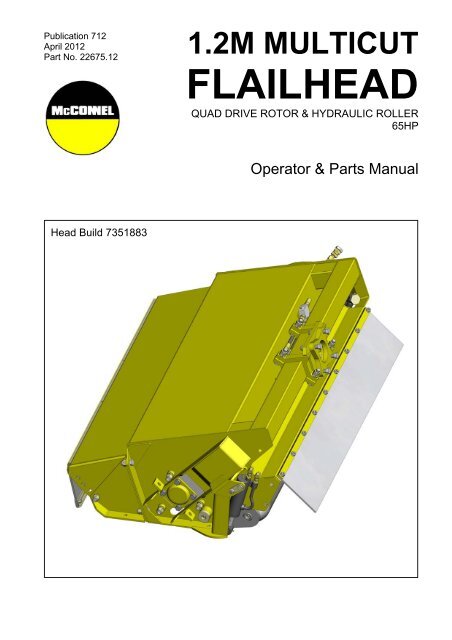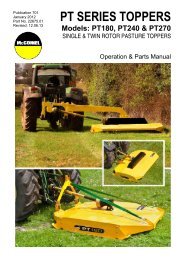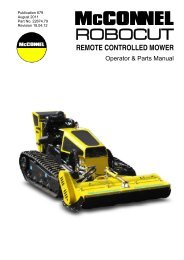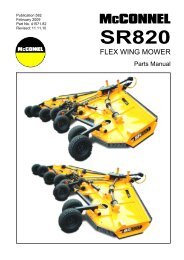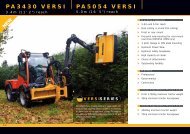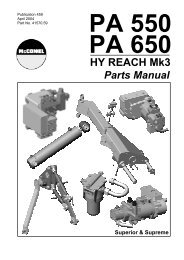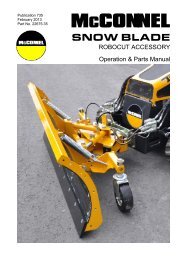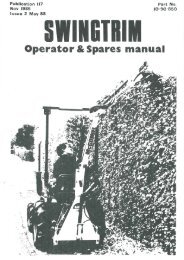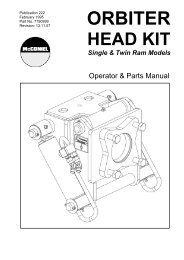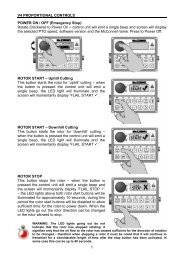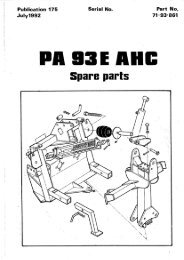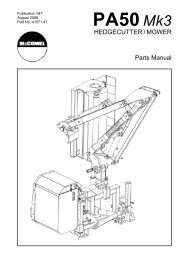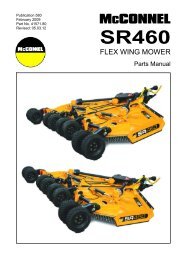You also want an ePaper? Increase the reach of your titles
YUMPU automatically turns print PDFs into web optimized ePapers that Google loves.
Publication 712<br />
April 2012<br />
Part No. 22675.12<br />
1.2M MULTICUT<br />
FLAILHEAD<br />
QUAD DRIVE ROTOR & HYDRAULIC ROLLER<br />
65HP<br />
<strong>Operator</strong> & <strong>Parts</strong> Manual<br />
Head Build 7351883
IMPORTANT<br />
VERIFICATION OF WARRANTY REGISTRATION<br />
DEALER WARRANTY INFORMATION & REGISTRATION VERIFICATION<br />
It is imperative that the selling dealer registers this machine with <strong>McConnel</strong> Limited before<br />
delivery to the end user – failure to do so may affect the validity of the machine warranty.<br />
To register machines go to the <strong>McConnel</strong> Limited web site at www.mcconnel.com, log<br />
onto ‘Dealer Inside’ and select the ‘Machine Registration button’ which can be found in<br />
the Service Section of the site. Confirm to the customer that the machine has been<br />
registered in the section below.<br />
Should you experience any problems registering a machine in this manner please contact<br />
the <strong>McConnel</strong> Service Department on 01584 875848.<br />
Registration Verification<br />
Dealer Name: ……………………..…………………………………………………………….<br />
Dealer Address: …….………………………………………………………………………….<br />
Customer Name: ……………………..…………………………………………………………<br />
Date of Warranty Registration: ……/……/...…… Dealer Signature: ………………..……<br />
NOTE TO CUSTOMER / OWNER<br />
Please ensure that the above section above has been completed and signed by the selling<br />
dealer to verify that your machine has been registered with <strong>McConnel</strong> Limited.<br />
IMPORTANT: During the initial ‘bedding in’ period of a new machine it is the customer’s responsibility<br />
to regularly inspect all nuts, bolts and hose connections for tightness and re-tighten if required. New<br />
hydraulic connections occasionally weep small amounts of oil as the seals and joints settle in – where<br />
this occurs it can be cured by re-tightening the connection – refer to torque settings chart below. The<br />
tasks stated above should be performed on an hourly basis during the first day of work and at least<br />
daily thereafter as part of the machines general maintenance procedure.<br />
TORQUE SETTINGS FOR HYDRAULIC FITTINGS<br />
HYDRAULIC HOSE ENDS<br />
PORT ADAPTORS WITH BONDED SEALS<br />
BSP Setting Metric BSP Setting Metric<br />
1/4” 18 Nm 19 mm 1/4” 34 Nm 19 mm<br />
3/8” 31 Nm 22 mm 3/8” 47 Nm 22 mm<br />
1/2” 49 Nm 27 mm 1/2” 102 Nm 27 mm<br />
5/8” 60 Nm 30 mm 5/8” 122 Nm 30 mm<br />
3/4” 80 Nm 32 mm 3/4” 149 Nm 32 mm<br />
1” 125 Nm 41 mm 1” 203 Nm 41 mm<br />
1.1/4” 190 Nm 50 mm 1.1/4” 305 Nm 50 mm<br />
1.1/2” 250 Nm 55 mm 1.1/2” 305 Nm 55 mm<br />
2” 420 Nm 70 mm 2” 400 Nm 70 mm
WARRANTY POLICY<br />
WARRANTY REGISTRATION<br />
All machines must be registered, by the selling dealer with <strong>McConnel</strong> Ltd, before delivery to the end<br />
user. On receipt of the goods it is the buyer’s responsibility to check that the Verification of Warranty<br />
Registration in the <strong>Operator</strong>’s Manual has been completed by the selling dealer.<br />
1. LIMITED WARRANTIES<br />
1.01. All machines supplied by <strong>McConnel</strong> Limited are warranted to be free from defects in material<br />
and workmanship from the date of sale to the original purchaser for a period of 12 months,<br />
unless a different period is specified.<br />
1.02. All spare parts supplied by <strong>McConnel</strong> Limited are warranted to be free from defects in material<br />
and workmanship from the date of sale to the original purchaser for a period of 6 months.<br />
1.03. The manufacturer will replace or repair for the purchaser any part or parts found, upon<br />
examination at its factory, to be defective under normal use and service due to defects in<br />
material or workmanship. Returned parts must be complete and unexamined.<br />
1.04. This warranty does not apply to any part of the goods, which has been subjected to improper or<br />
abnormal use, negligence, alteration, modification, fitment of non-genuine parts, accident<br />
damage, or damage resulting from contact with overhead power lines, damage caused by<br />
foreign objects (e.g. stones, iron, material other than vegetation), failure due to lack of<br />
maintenance, use of incorrect oil or lubricants, contamination of the oil, or which has served its<br />
normal life. This warranty does not apply to any expendable items such as blades, flails, flap<br />
kits, skids, soil engaging parts, shields, guards, wear pads or pneumatic tyres.<br />
1.05. Temporary repairs and consequential loss - i.e. oil, downtime and associated parts are<br />
specifically excluded from the warranty.<br />
1.06. Warranty on hoses is limited to 12 months and does not include hoses which have suffered<br />
external damage. Only complete hoses may be returned under warranty, any which have been<br />
cut or repaired will be rejected.<br />
1.07. Machines must be repaired immediately a problem arises. Continued use of the machine after a<br />
problem has occurred can result in further component failures, for which <strong>McConnel</strong> Ltd cannot<br />
be held liable, and may have safety implications.<br />
1.08. Except as provided herein, no employee, agent, dealer or other person is authorised to give any<br />
warranties of any nature on behalf of <strong>McConnel</strong> Ltd.<br />
1.09. For machine warranty periods in excess of 12 months the following additional exclusions shall<br />
apply:<br />
1) Hoses, external seals, exposed pipes and hydraulic tank breathers.<br />
2) Filters.<br />
3) Rubber mountings.<br />
4) External electric wiring.<br />
1.10. All service work, particularly filter changes, must be carried out in accordance with the<br />
manufacturer’s service schedule. Failure to comply will invalidate the warranty. In the event of a<br />
claim, proof of the service work being carried out may be required.<br />
NB Warranty cover will be invalid if any non-genuine parts have been fitted or used. Use of<br />
non-genuine parts may seriously affect the machine’s performance and safety. <strong>McConnel</strong> Ltd<br />
cannot be held responsible for any failures or safety implications that arise due to the use of<br />
non-genuine parts.
2. REMEDIES AND PROCEDURES<br />
2.01. The warranty is not effective unless the Selling Dealer registers the machine, via the <strong>McConnel</strong><br />
web site and confirms the registration to the purchaser by completing the confirmation form in<br />
the operator’s manual.<br />
2.02. Any fault must be reported to an authorised <strong>McConnel</strong> dealer as soon as it occurs. Continued<br />
use of a machine, after a fault has occurred, can result in further component failure for which<br />
<strong>McConnel</strong> Ltd cannot be held liable.<br />
2.03. Repairs should be undertaken within two days of the failure. Claims submitted for repairs<br />
undertaken more than 2 weeks after a failure has occurred, or 2 days after the parts were<br />
supplied will be rejected, unless the delay has been authorised by <strong>McConnel</strong> Ltd.<br />
2.04. All claims must be submitted, by an authorised <strong>McConnel</strong> Service Dealer, within 30 days of the<br />
date of repair.<br />
2.05. Following examination of the claim and parts the manufacture will pay, at their discretion, for<br />
any valid claim the cost of any parts and an appropriate labour allowance if applicable.<br />
2.06. The submission of a claim is not a guarantee of payment.<br />
2.07. Any decision reached by <strong>McConnel</strong> Ltd. is final.<br />
3. LIMITATION OF LIABILITY<br />
3.01. The manufacturer disclaims any express (except as set forth herein) and implied warranties<br />
with respect to the goods including, but not limited to, merchantability and fitness for a particular<br />
purpose.<br />
3.02. The manufacturer makes no warranty as to the design, capability, capacity or suitability for use<br />
of the goods.<br />
3.03. Except as provided herein, the manufacturer shall have no liability or responsibility to the<br />
purchaser or any other person or entity with respect to any liability, loss, or damage caused or<br />
alleged to be caused directly or indirectly by the goods including, but not limited to, any indirect,<br />
special, consequential, or incidental damages resulting from the use or operation of the goods<br />
or any breach of this warranty. Notwithstanding the above limitations and warranties, the<br />
manufacturer’s liability hereunder for damages incurred by the purchaser or others shall not<br />
exceed the price of the goods.<br />
3.04. No action arising out of any claimed breach of this warranty or transactions under this warranty<br />
may be brought more than one (1) year after the cause of the action has occurred.<br />
4. MISCELLANEOUS<br />
4.01. The manufacturer may waive compliance with any of the terms of this limited warranty, but no<br />
waiver of any terms shall be deemed to be a waiver of any other term.<br />
4.02. If any provision of this limited warranty shall violate any applicable law and is held to be<br />
unenforceable, then the invalidity of such provision shall not invalidate any other provisions<br />
herein.<br />
4.03. Applicable law may provide rights and benefits to the purchaser in addition to those provided<br />
herein.
DECLARATION OF CONFORMITY<br />
Conforming to EU Machinery Directive 2006/42/EC<br />
We,<br />
McCONNEL LIMITED, Temeside Works, Ludlow, Shropshire SY8 1JL, UK<br />
Hereby declare that:<br />
The Product; Hydraulic Arm Mounted Flailhead<br />
Product Code; BD12, BD16, F110, F112, F115, F012, F016<br />
Serial No. & Date ………………………………… Type …………………………<br />
Manufactured in; United Kingdom<br />
Complies with the required provisions of the Machinery Directive 2006/42/EC<br />
The machinery directive is supported by the following harmonized standards;<br />
BS EN ISO 14121-1 (2007) Safety of machinery - Risk assessment, Part 1:<br />
Principles Part 2: practical guide and examples of methods.<br />
BS EN ISO 12100-1 (2010) Safety of machinery - Part 1: Basic terminology and<br />
methodology Part 2: Technical principles.<br />
BS EN 349(1993)+ A1 (2008) Safety of machinery - Minimum distances to avoid the<br />
entrapment with human body parts.<br />
BS EN 953 (1998) Safety of machinery - Guards General requirements for the<br />
design and construction of fixed and movable guards.<br />
BS EN 982(1996)+ A1 (2008) Safety requirements for fluid power systems and their<br />
components. Hydraulics<br />
McCONNEL LIMITED operates an ISO 9001:2008 quality management system,<br />
certificate number: FM25970.<br />
This system is continually assessed by the;<br />
British Standards Institution (BSI), Beech House, Milton Keynes, MK14 6ES, UK<br />
BSI is accredited by UK Accreditation Service, accreditation number: UKAS 003.<br />
The EC declaration only applies if the machine stated above is used in<br />
accordance with the operating instructions.<br />
Signed …………………................ Responsible Person<br />
CHRISTIAN DAVIES on behalf of McCONNEL LIMITED<br />
Status: General Manager Date: May 2011
CONTENTS<br />
Page No.<br />
<strong>Operator</strong> Section<br />
General Information 3<br />
Safety Information 5<br />
Pre-Operational Checks 9<br />
Roller Positions 10<br />
Flailhead Arrangement for Mowing 11<br />
Flailhead Arrangement for Hedge Cutting 13<br />
Maintenance 17<br />
<strong>Parts</strong> Section<br />
Flail Head Assembly 22<br />
Rotor Assembly 24<br />
Quad Drive Assembly 25<br />
Drive Module 26<br />
Motor Cover 27<br />
Hydraulic Roller Rams 28<br />
Hydraulic Roller Assembly 30<br />
Check Valve Assembly 31<br />
Front Flap Kit – Optional Extra 32<br />
Decal Kit 33
GENERAL INFORMATION<br />
Always read this manual before fitting or operating the machine – whenever<br />
any doubt exists contact your dealer or the <strong>McConnel</strong> Service Department for<br />
advice and assistance.<br />
Use only <strong>McConnel</strong> Genuine Service <strong>Parts</strong> on <strong>McConnel</strong> Equipment and Machines<br />
DEFINITIONS – The following definitions apply throughout this manual:<br />
WARNING<br />
An operating procedure, technique etc., which –<br />
can result in personal injury or loss of life if not observed carefully.<br />
CAUTION<br />
An operating procedure, technique etc., which –<br />
can result in damage to either machine or equipment if not observed carefully.<br />
NOTE<br />
An operating procedure, technique etc., which –<br />
is considered essential to emphasis.<br />
LEFT AND RIGHT HAND<br />
This term is applicable to the machine when attached to the tractor and is viewed<br />
from the rear – this also applies to tractor references.<br />
MACHINE & DEALER INFORMATION<br />
Record the Serial Number of your machine on this page and always quote this number<br />
when ordering parts. Whenever information concerning the machine is requested<br />
remember also to state the make and model of tractor to which the machine is fitted.<br />
Machine Serial Number:<br />
Machine Model details:<br />
Dealer Name:<br />
Dealer Address:<br />
Dealer Telephone No:<br />
Dealer Email Address:<br />
Installation Date:<br />
3
This machine has the potential to be extremely dangerous, in the wrong hands it can kill or<br />
maim. It is therefore imperative that both owner, and operator of this machine, read and<br />
understand the following section to ensure that they are fully aware of the dangers that do,<br />
or may exist, and their responsibilities surrounding the use and operation of the machine.<br />
The operator of this machine is responsible not only for their own safety but equally for the<br />
safety of others who may come into the close proximity of the machine, as the owner you<br />
are responsible for both.<br />
When the machine is not in use the cutting head should be lowered to rest on the ground.<br />
In the event of a fault being detected with the machine’s operation it should be stopped<br />
immediately and not used again until the fault has been corrected by a qualified technician.<br />
POTENTIAL SIGNIFICANT DANGERS ASSOCIATED WITH THE USE OF THIS MACHINE:<br />
▲ Being hit by debris thrown by rotating components.<br />
▲ Being hit by machine parts ejected through damage during use.<br />
▲ Being caught on a rotating power take-off (PTO) shaft.<br />
▲ Being caught in other moving parts i.e.: belts, pulleys and cutting heads.<br />
▲ Electrocution from Overhead Power Lines (by contact with or ‘flashover’ from).<br />
▲ Being hit by cutting heads or machine arms as they move.<br />
▲ Becoming trapped between tractor and machine when hitching or unhitching.<br />
▲ Tractor overbalancing when machine arm is extended.<br />
▲ Injection of high-pressure oil from hydraulic hoses or couplings.<br />
▲ Machine overbalancing when freestanding (out of use).<br />
▲ Road traffic accidents due to collision or debris on the road.<br />
5
BEFORE USING THIS MACHINE YOU MUST:<br />
▲ Ensure you read all sections of the operator handbook.<br />
▲ Ensure the operator is, or has been, properly trained to use the machine.<br />
▲ Ensure the operator has been issued with and reads the operator handbook.<br />
▲ Ensure the operator understands and follows the instructions in operator handbook.<br />
▲ Ensure the tractor front, rear and side(s) are fitted with metal mesh or polycarbonate<br />
guards of suitable size and strength to protect the operator against thrown debris or<br />
parts.<br />
▲ Ensure tractor guards are fitted correctly, are undamaged and kept properly<br />
maintained.<br />
▲ Ensure that all machine guards are in position, are undamaged, and are kept<br />
maintained in accordance with the manufacturer’s recommendations.<br />
▲ Ensure flails and their fixings are of a type recommended by the manufacturer, are<br />
securely attached and that none are missing or damaged.<br />
▲ Ensure hydraulic pipes are carefully and correctly routed to avoid damage by chaffing,<br />
stretching or pinching and that they are held in place with the correct fittings.<br />
▲ Always follow the manufacturer’s instructions for attachment and removal of the<br />
machine from the tractor.<br />
▲ Check that the machine fittings and couplings are in good condition.<br />
▲ Ensure the tractor meets the minimum weight recommendations of the machine’s<br />
manufacturer and that ballast is used as necessary.<br />
▲ Always inspect the work area thoroughly before starting to note obstacles and remove<br />
wire, bottles, cans and other debris.<br />
▲ Use clear suitably sized warning signs to alert others to the nature of the machine<br />
working within that area. Signs should be placed at both ends of the work site. (It is<br />
recommended that signs used are of a size and type specified by the Department of<br />
Transport and positioned in accordance with their, and the Local Highways Authority,<br />
guidelines).<br />
▲ Ensure the operator is protected from noise. Ear defenders should be worn and tractor<br />
cab doors and windows must be kept closed. Machine controls should be routed<br />
through proprietary openings in the cab to enable all windows to be shut fully.<br />
▲ Always work at a safe speed taking account of the conditions i.e.: terrain, highway<br />
proximity and obstacles around and above the machine. Extra special attention should<br />
be applied to Overhead Power Lines. Some of our machines are capable of reach in<br />
excess of 8 metres (26 feet) this means they have the potential to well exceed, by<br />
possibly 3 metres (9’ 9”), the lowest legal minimum height of 5.2 metres from the<br />
ground for 11,000 and 33,000 volt power lines. It cannot be stressed enough the<br />
dangers that surround this capability, it is therefore vital that the operator is fully aware<br />
of the maximum height and reach of the machine, and that they are fully conversant<br />
with all aspects regarding the safe minimum distances that apply when working with<br />
machines in close proximity to Power Lines. (Further information on this subject can be<br />
obtained from the Health & Safety Executive or your Local Power Company).<br />
6
▲ Always disengage the machine, kill the tractor engine, remove and pocket the key<br />
before dismounting for any reason.<br />
▲ Always clear up all debris left at the work area, it may cause hazard to others.<br />
▲ Always ensure when you remove your machine from the tractor that it is left in a safe<br />
and stable position using the stands and props provided and secured if necessary.<br />
WHEN NOT TO USE THIS MACHINE:<br />
▲ Never attempt to use this machine if you have not been trained to do so.<br />
▲ Never use a machine until you have read and understood the operator handbook, are<br />
familiar with it, and practiced the controls.<br />
▲ Never use a machine that is poorly maintained.<br />
▲ Never use a machine if guards are missing or damaged.<br />
▲ Never use a machine on which the hydraulic system shows signs of wear or damage.<br />
▲ Never fit, or use, a machine on a tractor that does not meet the manufacturer’s<br />
minimum specification level.<br />
▲ Never use a machine fitted to a tractor that does not have suitable front, rear and<br />
side(s) cab guarding made of metal mesh or polycarbonate.<br />
▲ Never use the machine if the tractor cab guarding is damaged, deteriorating or badly<br />
fitted.<br />
▲ Never turn a machine cutting head to an angle that causes debris to be ejected<br />
towards the cab.<br />
▲ Never start or continue to work a machine if people are nearby or approaching - Stop<br />
and wait until they are at a safe distance before continuing. WARNING: Some Cutting<br />
Heads may continue to ‘freewheel’ for up to 40 seconds after being stopped.<br />
▲ Never attempt to use a machine on materials in excess of its capability.<br />
▲ Never use a machine to perform a task it has not been designed to do.<br />
▲ Never operate the tractor or machine controls from any position other than from the<br />
driving seat, especially whilst hitching or unhitching the machine.<br />
▲ Never carry out maintenance of a machine or a tractor whilst the engine is running –<br />
the engine should be switched off, the key removed and pocketed.<br />
▲ Never leave a machine unattended in a raised position – it should be lowered to the<br />
ground in a safe position on a level firm site.<br />
▲ Never leave a tractor with the key in or the engine running.<br />
▲ Never carry out maintenance on any part or component of a machine that is raised<br />
unless that part or component has been properly substantially braced or supported.<br />
▲ Never attempt to detect a hydraulic leak with your hand – use a piece of cardboard.<br />
▲ Never allow children near to, or play on, a tractor or machine under any circumstances.<br />
7
ADDITIONAL SAFETY ADVICE<br />
Training<br />
<strong>Operator</strong>s need to be competent and fully capable of operating this machine in a safe and<br />
efficient way prior to attempting to use it in any public place. We advise therefore that the<br />
prospective operator make use of relevant training courses available such as those run by<br />
the Agricultural Training Board, Agricultural Colleges, Dealers and <strong>McConnel</strong>.<br />
Working in Public Places<br />
When working in public places such as roadsides, consideration should be paid to others<br />
in the vicinity. Stop the machine immediately when pedestrians, cyclists and horse riders<br />
etc. pass. Restart only when they are at a distance that causes no risk to their safety.<br />
Warning Signs<br />
It is advisable that any working area be covered by suitable warning signs and statutory in<br />
public places. Signs should be highly visible and well placed in order to give clear<br />
advanced warning of the hazard. Contact the Department of Transport or your Local<br />
Highways Authority to obtain detailed information on this subject. The latter should be<br />
contacted prior to working on the public highway advising them of the time and location of<br />
the intended work asking what is required by way of signs and procedure. – ‘Nonauthorised<br />
placement of road signs may create offences under the Highways Act’.<br />
Suggested Warning Signs Required<br />
“Road works ahead” warning sign with a supplementary “Hedge cutting” plate. “For 1<br />
mile” or appropriate shorter distance may be added to the plate.<br />
“Road narrows” warning sign with supplementary “Single file traffic” plate.<br />
White on blue “Keep right” (*) arrow sign on rear of machine.<br />
* Note – this applies to UK Market machines where traffic passes to the right of a machine<br />
working in the same direction as the traffic flow. The direction, use and colour of the arrow<br />
sign will depend on the country of use and the Local Highway Authorities regulations in the<br />
locality.<br />
Use of Warning Signs<br />
▲ On two-way roads one set of signs is needed facing traffic in each direction.<br />
▲ Work should be within 1 mile of the signs.<br />
▲ Work only when visibility is good and at times of low risk e.g.: NOT during ‘rush-hour’.<br />
▲ Vehicles should have an amber-flashing beacon.<br />
▲ Ideally, vehicles should be conspicuously coloured.<br />
▲ Debris should be removed from the road and path as soon as practicable, and at<br />
regular intervals, wearing high visibility clothing and before removing the hazard<br />
warning signs.<br />
▲ Collect all road signs promptly when the job is completed.<br />
Although the information given here covers a wide range of safety subjects, it is impossible to<br />
predict every eventuality that can occur under differing circumstances whilst operating this<br />
machine. No advice given here can replace ‘good common sense’ and ‘total awareness’ at all times,<br />
but will go a long way towards the safe use of your <strong>McConnel</strong> machine.<br />
8
PRE-OPERATIONAL CHECKS<br />
Check all bolts are tight and that the torque figures are correct for the specific locations<br />
indicated below:<br />
52 Nm<br />
Motor Bolts<br />
Roller End Capscrews<br />
203 Nm<br />
Rotor Bolts<br />
Flail Bolts<br />
Roller Bracket Bolts<br />
IMPORTANT<br />
On the first day of use with a<br />
new flailhead, nuts should be<br />
checked for tightness every<br />
hour and retightened if required.<br />
Thereafter they should be<br />
checked on a daily basis prior to<br />
use of the machine.<br />
Torque nuts to the settings<br />
stated above.<br />
9
OPERATION<br />
Material Thickness Limitations<br />
Hydraulic Roller Height<br />
Care must always be adopted when setting the hydraulic roller to the required working<br />
height – the roller should only be positioned above the cut height for hedge work, for all<br />
mowing duties the roller must always be positioned below the cutting height of the flails,<br />
failure to observe this will result in the flails contacting the ground which is both dangerous<br />
to persons and damaging to machine components.<br />
Unlike manually adjusted rollers, hydraulic rollers do not have predetermined height<br />
settings, therefore operator’s must use their own judgement to set the roller at the optimum<br />
height for the work they are doing - this will be become easier with practice but in the<br />
interim learning period it is advisable to visually ‘double check’ any height adjustments<br />
before moving the head into work.<br />
Roller Working Positions<br />
Hedge Cutting Position (Above flails)<br />
Mowing Positions (Below flails)<br />
NEVER OPERATE WITH ROLLER REMOVED<br />
10
FLAILHEAD ARRANGEMENT – GRASS & VERGE MOWING<br />
Roller Height<br />
The roller position must always be set below the level of the skids, or rotor if skids are not<br />
fitted - refer to roller positions on previous page.<br />
Rotor Direction<br />
When mowing the rotor must always cut with an upwards rotation.<br />
Front Hood<br />
The front hood has 4 adjustment positions for height – the lowest possible position which<br />
allows the material to be cut to enter the head should always be used.<br />
Operate with front hood in lowest possible position that allows material to be cut to enter the head.<br />
11
CAUTION:<br />
Before attempting grass mowing ensure the flail head is set up correctly.<br />
TRACTOR FORWARD SPEED<br />
The material being cut determines tractor<br />
forward speed. Forward speed can be as fast<br />
as that which allows the flail head sufficient<br />
time to cut the vegetation properly.<br />
Too fast a speed will be indicated by over<br />
frequent operation of the breakaway system,<br />
a fall off in tractor engine revs and a poor<br />
finish to the work leaving ragged uncut tufts<br />
and poorly mulched cuttings.<br />
12
FLAILHEAD ARRANGEMENT - HEDGE CUTTING (Standard Duty)<br />
Roller Height<br />
The roller position must always be set above the level of the rotor in positions 1 - refer to<br />
roller positions page.<br />
Rotor Direction<br />
For the best finish the rotor should cut with an upwards rotation.<br />
Front Hood<br />
On universal heads the front rubber flaps, and skids if fitted, may be removed to aid the<br />
entry of the material to be cut into the flail head.<br />
The front hood has 4 adjustment positions for height – the lowest possible position which<br />
allows the material to be cut to enter the head should always be used.<br />
Operate with front hood in lowest possible position that allows material to be cut to enter the head.<br />
13
CAUTION:<br />
Before attempting hedge cutting ensure the flail head is set up correctly.<br />
FLAILHEAD ARRANGEMENT - HEDGE CUTTING (Heavy Duty)<br />
Roller Height<br />
The roller position must always be set above the level of the rotor in positions 1 - refer to<br />
roller position page.<br />
Rotor Direction<br />
Where the size and density of material to be cut makes it necessary for the front hood and<br />
carrier plates to be removed to allow the rotor to cut, the rotor must always cut in a<br />
downwards rotation. It must be noted that this will result in a poorer finish to the work and<br />
will require more power than upward cutting.<br />
14
HEDGECUTTING PROCEDURE<br />
WARNING!<br />
Never cut on the blind side of the hedge<br />
It is impossible to see potential hazards or<br />
dangers and the position of the flail head may<br />
allow debris to be propelled through the<br />
hedge towards the tractor and the operator.<br />
Cut the side and bottom of the field side first. This<br />
leaves the maximum thickness of hedge on the road<br />
side to prevent the possibility of debris being thrown<br />
through the hedge into the path of oncoming vehicles.<br />
Cut the side and bottom of the road side.<br />
Top cut the hedge to the height required.<br />
15
FLAIL IDENTIFICATION<br />
The Illustrations below show the various flails and fixings and their specific part numbers.<br />
16
MAINTENANCE<br />
Frequently inspect the rotor assembly for damaged or missing flails – Never operate or<br />
attempt to run the rotor with flails missing, imbalance will cause severe vibration and can<br />
rapidly damage the rotor shaft bearings. As an emergency measure, if a flail is broken off<br />
or missing, removal of an opposing flail on the opposite side of the rotor will retain the<br />
balance. Replace the flails at the earliest possible opportunity and always replace in<br />
opposite pairs. Never match up a new flail with a sharpened or damaged flail as the latter<br />
will be lighter thus causing imbalance of the rotor.<br />
Blunt flails absorb more power and leave an untidy finish to the work. They should be<br />
sharpened on a grindstone or with a portable grinder periodically. Always wear protective<br />
gear when sharpening flails.<br />
Check on a regular basis, prior to operation that all bolts are tight and that torque figures<br />
are correct – refer to pre-operational check page details.<br />
Lubrication<br />
Grease daily the points indicated in the illustration below.<br />
17
ROTOR SHAFT ALIGNMENT<br />
Rotor shaft hub failure can usually be attributed to rotor misalignment caused by distortion<br />
of the flailhead due to the hood or casing receiving a violent blow against an obstruction<br />
during work or by dropping the flail head heavily to the ground. These actions should,<br />
wherever possible, be avoided.<br />
Where rotor alignment is incorrect or when refitting or replacing rotor components<br />
it is imperative that the following procedure for re-assembly is adhered to:<br />
Procedure for re-assembly is as follows:-<br />
1. Press the new bearing fully into the housing and then press the complete assembly<br />
onto the rotor shaft until the bearing inner race is firmly against the rotor shoulder.<br />
2. Support the head off the ground in a vertical position. Offer up the complete rotor shaft<br />
into the casing, and locate the lower mounting bolts. Tighten the nuts sufficiently to<br />
take out all movement and then check the hole alignment at the top end of the casing.<br />
If the mounting bolts will not readily fit into place, release the lower bolts and shim<br />
between the casing boss and bearing housing until the top holes are aligned.<br />
3. Locate the three top mounting bolts and then tighten the three lower bolts and nuts<br />
completely – torque to a setting of approximately 162Nm (120 ft-lb.).<br />
4. Check for clearance between the top bearing housing and casing, and completely<br />
shim all gaps before tightening the three mounting bolts to the same torque as above.<br />
If there is not clearance between the housing and casing, the bosses will need to be<br />
‘ground off’ in order to provide clearance for the adding of shims. Failure to shim all<br />
gaps will tend to draw the bearing from the shaft when the bolts are tightened.<br />
Note<br />
Two sizes of shim are available from <strong>McConnel</strong>; these are:<br />
Part No. 8121043 for 0.4mm (.015”)<br />
Part No. 8121044 for 0.6mm (.025”)<br />
Alternatively thin spacing washers .2 may be used. The welded bosses in the casing<br />
may be of varying depths - this is a jigging requirement during manufacture of the<br />
head and should not be regarded as a fault.<br />
5. Finally, with the flail head horizontal, turn the rotor over by hand. There should be no<br />
binding or tight spots. Replace motor but do not bolt in place, when the rotor is rotated<br />
by hand the motor should not move. Movement up and down or side to side indicates<br />
a problem.<br />
Warning: Failure to correctly align the rotor shaft may result in the motor shaft breaking.<br />
6. The Coupling should be fitted on to the Motor and the nut tightened to a maximum<br />
torque setting of 80Nm (60 ft-lb.) - Do not exceed this value.<br />
Prior to the fitting of the motor, the hub and coupling splines should be liberally coated<br />
with Morris’s K65MS high temperature grease, or equivalent. Experience has<br />
indicated that in addition to the pre-pack with Morris’s K64MS grease supplied,<br />
greasing the rotor bearings, particularly the drive side, twice daily can considerably<br />
improve the longevity of the drive hub and coupling.<br />
18
Rotor Shaft Shim Fitment<br />
19
For best performance …<br />
USE ONLY GENUINE McCONNEL SERVICE PARTS<br />
To be assured of the latest design improvements purchase your<br />
‘Genuine Replacements’ from the ‘Original Equipment Manufacturer’<br />
McCONNEL LIMITED<br />
Through your local Dealer or Stockist<br />
Always quote:<br />
• Machine Type<br />
• Serial Number<br />
• Part Number<br />
Design improvements may alter some of the parts listed in this manual –<br />
the latest part will always be supplied when it is interchangeable with an earlier one.<br />
21
1.2M MULTICUT FLAILHEAD ASSEMBLY (65HP)<br />
Module(s): 7351883<br />
McCONNEL<br />
22
1.2M MULTICUT FLAILHEAD ASSEMBLY (65HP)<br />
Module(s): 7351883<br />
McCONNEL<br />
REF. QTY. PART No. DESCRIPTION<br />
7351883 1.2M MULTICUT FLAILHEAD (65HP)<br />
1 1 22100.07 1.2M FLAIL CASING<br />
2 1 7190314 REAR FLAP<br />
3 1 7190313 CLAMP STRIP<br />
4 9 9313065 SETSCREW<br />
5 11 9163005 CLEVELOC<br />
6 2 9100033 NYLOC NUT<br />
7 1 41695.02 FRONT HOOD<br />
8 1 7290388 HOOD BRACKET - LH<br />
9 1 7290387 HOOD BRACKET - RH<br />
10 1 41700.01 HINGE PIN<br />
11 2 9200023 BOLT<br />
12 6 30.073.25 BOLT<br />
13 8 12.714.75 BOLT<br />
14 16 9100024 SELF-LOCKING FLANGE NUT<br />
15 2 7198332 CLAMP<br />
16 1 7198330 CLAMP<br />
17 1 9100205 SPRING WASHER<br />
18 1 7193063 PIPE CLAMP(1 PAIR)<br />
19 1 06.418.05 CLAMP PLATE<br />
20 1 9213145 BOLT<br />
21 1 22103.08 1.2M ROLLER ASSEMBLY (HYDRAULIC)<br />
22 1 22091.01 HYDRAULIC RAM ASSEMBLY (50mm)<br />
23 2 22101.05 ROLLER PIVOT STUD<br />
24 2 08.297.04 PLASTIC BUSH<br />
25 4 8629218 LIP SEAL<br />
26 1 22091.02 HYDRAULIC RAM ASSEMBLY (45mm)<br />
27 2 22102.01 PIN<br />
28 2 901121 GREASE NIPPLE<br />
29 2 22106.01 SHIM - 1.5mm<br />
30 2 9100108 FLAT WASHER<br />
31 2 04.282.24 STUD<br />
32 4 8581190 ADAPTOR ELBOW (90°)<br />
33 1 7418737 CHECK VALVE KIT<br />
34 4 7390005 SPACER<br />
35 1 22497.02 1.2m QUAD DRIVE ROTOR MODULE (F10SE)<br />
36 1 22496.04 COVER MODULE (RH)<br />
37 1 22498.03 QUAD DRIVE<br />
38 1 7350709 DECAL KIT<br />
39 1 22495.05 125LPM DRIVE MODULE (65HP)<br />
40 1 21541.01 FRONT FLAP KIT (HEAVY DUTY)<br />
23
COMPONENT DESCRIPTION<br />
Module(s):<br />
McCONNEL<br />
REF. QTY. PART No. DESCRIPTION<br />
22497.02 1.2M QUAD DRIVE ROTOR<br />
1 1 22269.01 1.2M ROTOR (QUAD DRIVE)<br />
2 4 9353097 CAPSCREW<br />
3 24 7390276 FLAIL (SINGLE EDGED)<br />
4 1 0901161 GREASE NIPPLE<br />
5 24 7314223 FLAIL PIVOT BUSH (NARROW)<br />
6 4 9163007 NYLOC NUT<br />
7 24 7314201 SPECIAL BOLT (UNF)<br />
8 48 0100206 SPRING WASHER<br />
9 24 0141006 CLEVELOC NUT (UNF)<br />
24
QUAD DRIVE ASSEMBLY<br />
Module(s): 22498.03<br />
McCONNEL<br />
REF. QTY. PART No. DESCRIPTION<br />
22498.03 MULTICUT QUAD DRIVE ASSEMBLY<br />
1 2 7190261 BEARING HOUSING<br />
2 6 9100024 SELF-LOCKING FLANGE NUT<br />
3 6 9200024 BOLT<br />
4 2 0901121 GREASE NIPPLE - STRAIGHT<br />
5 2 0901125 GREASE NIPPLE - 45°<br />
6 4 9300144 CAPSCREW<br />
7 1 7190292 COVER PLATE<br />
8 4 9100205 SPRING WASHER<br />
9 4 9313045 SETSCREW<br />
10 2 0600018 BALL BEARING<br />
11 1 22269.02 DRIVE HUB - QUAD DRIVE<br />
12 1 7190022 INTERNAL CIRCLIP<br />
13 as req'd 8121043 SHIM - 0.4mm<br />
14 as req'd 8121044 SHIM - 0.6mm<br />
25
125LPM DRIVE MODULE (65HP)<br />
Module(s): 22495.05<br />
McCONNEL<br />
REF. QTY. PART No. DESCRIPTION<br />
22495.05 125LPM DRIVE MODULE 65HP<br />
1 1 8301304 MOTOR (BACK PORTED) - 65HP<br />
2 1 7190015 LOCATING WASHER<br />
3 1 43390.02 DRIVE COUPLING - 27 TOOTH<br />
4 2 8650106 BONDED SEAL<br />
5 2 8581295 ADAPTOR<br />
6 2 8501254 HOSE - 1" BSP FS/FS x 1900mm<br />
7 2 05.433.03 PLUG<br />
26
MOTOR COVER ASSEMBLY<br />
Module(s): 22496.04<br />
McCONNEL<br />
REF. QTY. PART No. DESCRIPTION<br />
22496.04 MOTOR COVER ASSEMBLY<br />
1 1 42282.04 MOTOR COVER<br />
2 4 30.073.25 BOLT<br />
3 5 9100024 SELF-LOCKING FLANGE NUT<br />
4 1 9200034 BOLT<br />
27
HYDRAULIC ROLLER RAMS – Ø50mm & Ø45mm<br />
Module(s): 22091.01, 22091.02<br />
McCONNEL<br />
28
HYDRAULIC ROLLER RAMS – Ø50mm & Ø45mm<br />
Module(s): 22091.01, 22091.02<br />
McCONNEL<br />
REF. QTY. PART No. DESCRIPTION<br />
22091.01 ROLLER RAM ASSEMBLY (50mm Bore)<br />
1 1 22092.01 ROLLER RAM<br />
2 1 22093.01 RAM ROD<br />
3 1 22094.01 PISTON<br />
4 1 22095.01 GLAND<br />
5 1 8629188 GUIDE RING<br />
6 1 8629187 PISTON SEAL<br />
7 1 9100022 SELF LOCKING NUT<br />
8 2 8581169 ADAPTOR<br />
9 2 8650102 BONDED SEAL<br />
10 2 1090002 BUSH<br />
11 2 0901121 GREASE NIPPLE<br />
12 1 8600302 O RING<br />
13 1 8609302 AE RING<br />
14 1 8629243 ROD WIPER<br />
15 1 8629244 ROD SEAL<br />
16 1 8700642 O RING<br />
REF. QTY. PART No. DESCRIPTION<br />
22091.02 ROLLER RAM ASSEMBLY (45mm Bore)<br />
1 1 22092.02 ROLLER RAM<br />
2 1 22093.01 RAM ROD<br />
3 1 22094.02 PISTON<br />
4 1 22095.02 GLAND<br />
5 1 8629246 GUIDE RING<br />
6 1 8629245 PISTON SEAL<br />
7 1 9100022 SELF LOCKING NUT<br />
8 2 8581169 ADAPTOR<br />
9 2 8650102 BONDED SEAL<br />
10 2 1090002 BUSH<br />
11 2 0901121 GREASE NIPPLE<br />
12 1 8600414 O RING<br />
13 1 8609414 AE RING<br />
14 1 8629243 ROD WIPER<br />
15 1 8629244 ROD SEAL<br />
16 1 8700642 O RING<br />
NOTE: This hydraulic roller system is designed to use rams of differing bores at each end.<br />
Rams may be fitted to either end of the roller but hose circuit must be as shown opposite.<br />
29
1.2M ROLLER ASSEMBLY (HYDRAULIC)<br />
Module(s): 22103.08<br />
McCONNEL<br />
REF. QTY. PART No. DESCRIPTION<br />
22103.08 1.2M ROLLER ASSEMBLY<br />
1 1 21394.03 1.2M ROLLER<br />
2 2 21394.32 ROLLER END CAP<br />
3 6 9343075 CAPSCREW<br />
4 2 0901121 GREASE NIPPLE<br />
5 1 22099.13 LH ROLLER BRACKET<br />
6 1 22099.14 RH ROLLER BRACKET<br />
7 2 9100108 FLAT WASHER<br />
8 2 9501406 SPLIT PIN<br />
9 4 0600111 BALL BEARING<br />
10 2 21523.31 BEARING SPACER<br />
11 2 0401230 EXTERNAL CIRCLIP<br />
12 2 0402240 INTERNAL SPIROLOX RING<br />
13 2 8629239 ROTARY SHAFT SEAL<br />
30
CHECK VALVE KIT (Hydraulic Roller)<br />
Module(s): 7418737<br />
McCONNEL<br />
REF. QTY. PART No. DESCRIPTION<br />
7418737 CHECK VALVE KIT (HYD. ROLLER)<br />
1 1 8132290 VALVE - DOUBLE PILOT CHECK<br />
2 4 8650102 BONDED SEAL<br />
3 4 8581169 ADAPTOR<br />
4 2 9100103 FLAT WASHER<br />
5 2 9100203 SPRING WASHER<br />
6 1 10.001.07 HOSE - 1/4" BSP FS/FS x 350mm<br />
7 1 10.001.25 HOSE - 1/4" BSP FS/FS x 1500mm<br />
8 2 9313073 SETSCREW<br />
9 1 10.001.24 HOSE - 1/4" BSP FS/FS x 1400mm<br />
10 2 10.001.39 HOSE - 1/4" BSP FS/FS x 2900mm<br />
31
1.2M FRONT FLAP KIT<br />
Module(s): 21541.01<br />
McCONNEL<br />
REF. QTY. PART No. DESCRIPTION<br />
21541.01 FRONT FLAP KIT (HEAVY DUTY)<br />
1 2 21544.01 FRONT FLAP<br />
2 2 21541.05 FLAP OUTER EDGE PLATE<br />
3 28 9293054 CUP HEAD SQUARE SCREW<br />
4 28 9143004 SELF-LOCKING NUT<br />
5 2 21541.06 CLAMP PLATE<br />
6 1 21544.02 MIDDLE FRONT FLAP<br />
7 1 21541.08 MIDDLE CLAMP PLATE<br />
8 1 21541.07 FLAP INNER EDGE PLATE<br />
9 1 7190304 CLAMP STRIP<br />
32
DECAL KIT<br />
Module(s): 7350709<br />
McCONNEL<br />
REF. QTY. PART No. DESCRIPTION<br />
7350709 FLAILHEAD DECAL KIT<br />
1 1 1335246 SERIAL No. PLATE<br />
2 4 7103230 POP RIVET<br />
3 1 1290738 DECAL - FLAILHEAD<br />
4 1 09.821.35 DECAL - COMBINED EURO<br />
5 1 1290392 DECAL - PARTS<br />
6 1 1290527 DECAL - McCONNEL<br />
7 1 21917.03 DECAL - 126 l/min (GREEN)<br />
33
<strong>McConnel</strong> Limited, Temeside Works, Ludlow, Shropshire SY8 1JL. England.<br />
Telephone: 01584 873131. Facsimile: 01584 876463. www.mcconnel.com


